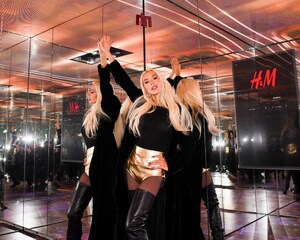NEW YORK, April 10, 2014 /PRNewswire/ -- Today, H&M publishes its twelfth Conscious Actions Sustainability Report. Some of the highlights during 2013 are the launch of H&M's roadmap for fair living wages, the first closed loop collection made with recycled material from collected garments and a doubling of the share of more sustainable cotton in the last two years.
"At H&M we want to use our scale to bring about systemic change to our industry and across our entire value chain. With size comes responsibility and we have the opportunity to bring about massive change all the way from improving the livelihood of a cotton farmer to lowering the impacts from washing and drying our clothes. We are proud of our achievements but also humbled by the challenges we face going forward," says Karl-Johan Persson, CEO at H&M.
The report contains a wide range of achievements covering every stage of H&M's product lifecycle, from design to how the customers take care of their garments.
- A Fair Living Wage roadmap was launched in close consultation with a variety of stakeholders. The challenges are complex, but the aim is clear: A fair living wage in the textile industry.
- Close to 100% of H&M stores worldwide participate in our global garment collecting initiative with the goal to create a closed loop for textiles. 3,047 tonnes of no longer wanted garments were collected.
- First closed loop products launched, made with 20% recycled material from collected garments.
- H&M started to implement the game changing water strategy developed together with WWF.
- H&M doubled the share of more sustainable cotton in the last two years and we are on target with 15.8% of the cotton being certified organic, Better Cotton or recycled. The goal is that all cotton should come from more sustainable sources by 2020 at the latest.
- More sustainable fabrics now represent 11% of our products' total material use - up from 9.1% in 2012.
- H&M launched its first products made with organic leather and organic silk.
- The amount of recycled polyester used in H&M's garments is equivalent to 9.5 million PET bottles.
- H&M was the first brand to sign the Fire and Building Safety Accord in Bangladesh.
- 894,975 garment workers in Bangladesh and India educated about their rights since 2008.
- Clevercare label launched, providing guidance for conscious garment care.
- 14% less electricity used per H&M store sqm since 2007. The goal is -20% by 2020.
- 340 million fewer litres of water used in denim production.
"H&M again sets the bar in sustainability reporting. Its commitment to sustainability and the transparency on targets and achievements serve as an inspiration for other brands in this sector. Considering the fact that H&M sources from 1,900 factories reaching 1,6 million people, the potential for change is immense," says Janet Mensink, International Programme Coordinator Cotton & Textiles for Solidaridad Network.
The report and a summary of its highlights are available to read and download at
www.hm.com/consciousactions2013
An archive of the press conference announcing the results from this year's report is available at http://www.theguardian.com/sustainable-business/hm-partner-zone/interactive/conscious-actions-sustainability-report-2013-live-stream
Contact persons:
Camilla Emilsson Falk, Head of Media Relations
Phone: +46 8 796 39 95
E-mail: [email protected]
H & M Hennes & Mauritz AB (publ) was founded in Sweden in 1947 and is quoted on NASDAQ OMX Stockholm. The company's business concept is to offer fashion and quality at the best price. In addition to H&M, the group includes the brands & Other Stories, Cheap Monday, COS, Monki and Weekday as well as H&M Home. The H&M Group has approximately 3,200 stores in 53 markets, including franchise markets. In 2013, sales including VAT were SEK 150,090 million and the number of employees is more than 116,000. For further information, visit hm.com.
SOURCE H&M
WANT YOUR COMPANY'S NEWS FEATURED ON PRNEWSWIRE.COM?
Newsrooms &
Influencers
Digital Media
Outlets
Journalists
Opted In




Share this article